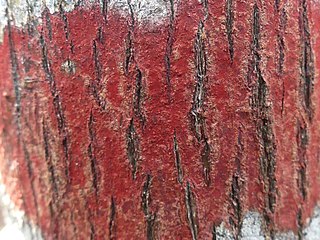Neomacounia nitida, or Macoun's shining moss, is an extinct moss that was found only in a small area of Ontario, and the sole species in the genus Neomacounia.

Segmentina nitida, the shining ram's-horn snail, is a species of minute, air-breathing, freshwater snail, an aquatic gastropod mollusc or micromollusc in the family Planorbidae, the ramshorn snails.

The Pyrenulales are an order of ascomycetous fungi within the class Eurotiomycetes and within the subphylum Pezizomycotina.
The Pyrenulaceae are a family of mostly lichenized fungi in the order Pyrenulales. The family was first named by German botanist Gottlob Ludwig Rabenhorst in 1870. Species in the family have a widespread distribution, but are especially prevalent in the tropics, where they grow with green algae on bark.
Nitida, Nitidum and Nitidus are forms of the Latin for "bright, shining, sleek, blooming, smart" and may refer to:

Pyrenula is a genus of lichen-forming fungi in the family Pyrenulaceae. The genus has a widespread distribution, especially in tropical regions, and contains about 200 species.

Architrypethelium is a genus of lichen-forming fungi in the family Trypetheliaceae.

Lonicera nitida is a species of flowering plant in the honeysuckle family. In English, it is sometimes given the common names box honeysuckle or Wilson's honeysuckle. It is widely used as a low hedging plant, and for topiary. It is also a popular low-maintenance ground cover plant for urban landscaping.

Passiflora nitida, the bell apple, is a tasty, but relatively unknown passion fruit. It is similar to P. laurifolia, with orange-yellow fruits that have a sweet, succulent pulp. It is a fast-growing tropical vine. Its flowers are blue and red, a bit like P. laurifolia and P. quadrangularis. The fruits grow up to 4 centimetres (1.6 in). The exact hardiness in unknown, but it is tropical and should be protected from prolonged temperatures below 50–55 °F (10–13 °C). It is not frost hardy. Passiflora nitida is the cousin of almost all the Passiflora species like P. actinia, P. flavicarpa, P. loefgrenii and so on. Its propagation is by seeds. The fruits are eaten fresh and reportedly quite good in flavor. The bell apple is a native to the Amazon jungle region. Passiflora nitida is also a useful fruit in a drink called Purple Passion. Passiflora nitida has one of the widest geographic ranges. It grows in the tropical lowlands from Costa Rica in the north and French Guiana in the northeast, through wide parts of Brazil.

Cenarrhenes is a monytypic genus in the family Proteaceae containing the single species Cenarrhenes nitida, known as the Port Arthur plum or native plum. Cenarrhenes nitida is an evergreen shrub to small tree endemic to the rainforests and scrublands of western Tasmania. It bears white flowers in late spring followed by the development of fleshy fruit.
Pyrenula muriciliata is a species of corticolous (bark-dwelling) and crustose lichen in the family Pyrenulaceae. It is found in Mauritius, where it grows on tree bark in parklands and forests.
Pyrenula luteopruinosa is a species of corticolous (bark-dwelling), crustose lichen in the family Pyrenulaceae. It has a neotropical distribution, occurring in Panama, Costa Rica, Puerto Rico, and Hawaii.

Pyrenula cruentata is a species of corticolous (bark-dwelling), crustose lichen in the family Pyrenulaceae. The lichen, characterized by its crimson-colored thallus and perithecial warts, has a neotropical distribution.

Pyrenula ochraceoflava is a species of corticolous, crustose lichen in the family Pyrenulaceae. It is a common lowland and coastal species with a pantropical distribution. Its distribution in the Pacific Ocean includes the Caroline Islands, Galápagos Islands, New Caledonia, Tuamotu, and Western Samoa. The lichen was first formally described by Finnish lichenologist William Nylander in 1858 as a species of Verrucaria. Richard Harris transferred it to the genus Pyrenula in 1989. The variety pacifica, found on the Cook Islands was proposed by Patrick McCarthy in 2000. It is distinguished from the nominate variety by its pigmented thallus and perithecia, ascospore size and shape, and the presence of a single transverse septum in its ascospores.
Pyrenula multicolorata is a species of corticolous (bark-dwelling), crustose lichen in the family Pyrenulaceae, first described in 2016. It is distinguished by its almost superficial ascomata with a hamathecium inspersed with orange crystals, and ascospores that contain three internal partitions (septa).









